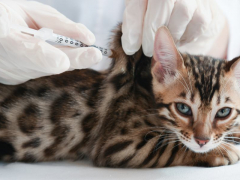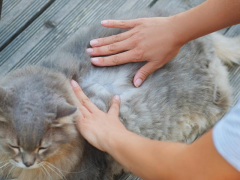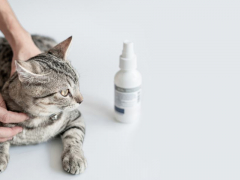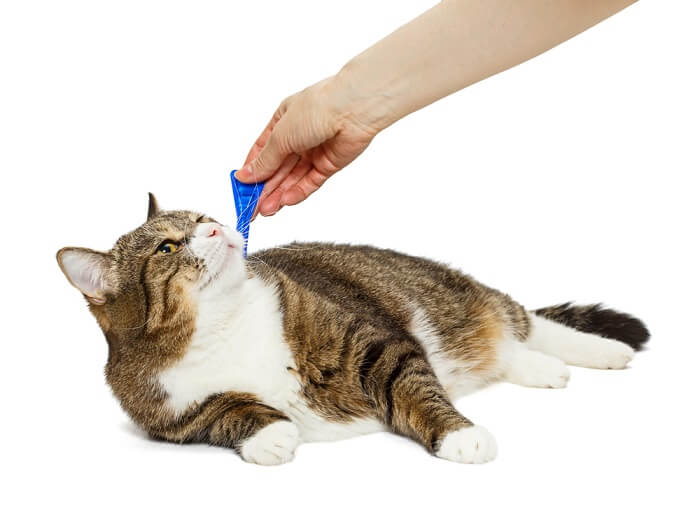
Frontline is a brand of topical, “spot-on” flea/tick treatment and prevention containing the ingredient fipronil. The patent on fipronil expired in 2010, leading to the release of many generic products. Frontline has since become only available as the products Frontline Plus and more recently, Frontline GOLD.
Frontline for Cats Overview

In this article, you’ll learn about the different Frontline products available for cats, the ingredients they contain, what types of parasitic pests they target, possible side effects to consider, and some frequently asked questions.
About Frontline for Cats

Fipronil is the primary active ingredient in all Frontline products for both dogs and cats. As per its indication, it kills fleas, kills ticks, and targets chewing lice. It can also kill mosquitoes. While not labeled for it, it has also been successful in treating for chiggers and the sarcoptic mange mite that causes scabies.
Fipronil is a phenylpyrazole antiparasitic agent, and is technically classified as a pesticide. In invertebrates (including insects like fleas and arachnids like ticks and mites), it interrupts GABA-regulated nerve channels, causing neurologic overexcitement, disruption and death.
Frontline “spot-on” products are applied to the surface of a small target area or “spot” of the skin, usually at the back of the head or neck.
Fipronil collects in the oils of the skin and hair, allowing for continual release, lending to its 30 day period of efficacy. Per the product label, it takes about 24 hours to spread throughout surface oils on skin and hair to provide complete protection.
It is important to note that while these pesky pests are affected by Frontline by coming in contact with the skin and don’t have to actually bite a kitty to die, Frontline products do not provide true repellency that would prevent fleas or ticks from coming in contact with a pet.
What Does Frontline Do for Cats?
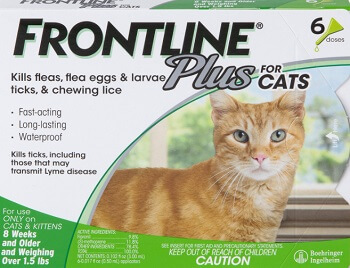
View On Chewy
Frontline products are among the only topical “spot-on” options for cats providing protection against both fleas and ticks. Other products for cats may only protect against fleas and some ticks, or just fleas.
While the original Frontline could only kill adult fleas and did not treat all life stages of the flea, Frontline Plus includes the addition of (S)-methoprene, which is an insect growth regulator that additionally targets flea eggs and flea larvae, helping to interrupt the life cycle and prevent new adults from hatching and developing.
Frontline GOLD additionally includes another insect growth regulator called pyriproxyfen that is more efficient at targeting flea eggs and larvae, eliminating fleas faster than its predecessor.
Side Effects of Frontline for Cats

When used properly, side effects to Frontline products are uncommon. Frontline products are only labeled for cats older than 8 weeks of age. Topical products like Frontline should never be ingested.
The most commonly reported effect is a temporary irritation at the application site. More red, irritated skin has been reported, but is considered rare. If this occurs, it is more likely a kitty has a hypersensitivity or allergy to one of the ingredients.
All three ingredients currently found in Frontline products (fipronil, (S)-methoprene, pyriproxyfen) generally appear to have a low potential for toxicity both topically and even if accidentally ingested.
However, the products are very bitter tasting. If a kitty were to lick recently applied Frontline off either themselves or a housemate, the bitter taste alone can lead to excessive drooling, agitation, and sometimes even vomiting.
According to DVM360’s article “Toxicology Brief: The 10 most common toxicoses in cats” this effect is typically not a true toxicity, but a sometimes dramatic reaction to the bitter taste. Providing milk or liquid from a tuna can help resolve the signs in short order.
To avoid this from happening, it is important to apply any topical flea/tick product to the skin in front of the shoulder blades at the back of the neck, a location even the most flexible cat cannot reach to lick. In multiple cat households where lots of co-grooming occurs, separating housemate kitties for up to 24 hours after application to allow the product to fully dry may be advisable.
Although Frontline products for dogs and cats contain the same active ingredients, there are slight differences in the percentages of active ingredients and inactive ingredients, so the dog products should never be shared with cats.
Using Caution With Other Flea/Tick Products

Some dog flea/tick products that used to be used in cats contain permethrin, which is extremely toxic to cats. Luckily, these products are now required to include a warning against use in cats.
While Frontline for Cats has been established as a safe product, the active ingredients may be found in other products in combination with other ingredients that are not safe for cats. This is especially the case with dog products like K9 Advtantix II that contains permethrin, which is extremely toxic to cats.
Fortunately, these products are now required to include a warning against use in cats. But just to be safe, when selecting a flea/tick product for your kitty, always make sure the product includes a picture of a cat and indicates the product is specifically for cats.
It is also always advisable if you have a pup and kitty who like to hang out together or groom each other, to separate them for 24 hours after applying a topical product to your dog, especially if the product contains permethrin.
If you have any concerns for potential toxicity, even if you think your kitty might have just licked some Frontline off her fur and is having a bitter taste reaction, it is always best to contact your veterinarian, or the ASPCA Animal Poison Control Center for further advice.
And lastly, topical products like Frontline have been known to cause skin and eye irritation in people. It is best to avoid contact with the solution during application and to wash your hands after.
Frontline for Cats Dosage

Frontline products are typically applied every 30 days for the best protection. Protection against ticks is limited to 30 days requiring a monthly application, though protection against fleas can be reportedly for up to 6 weeks according to the manufacturer.
Always follow all instructions on the packaging for any topical product you use for your kitty. Frontline vials come with a perforated applicator tip that needs to be broken off or snipped off with scissors. It is then best applied by parting the fur and applying the entire contents of the vial to a cat’s skin along the back of the neck in front of the shoulders where a kitty cannot reach to lick it off of himself.
While Frontline products are considered to be waterproof, make sure not to bathe your kitty for 24-48 hours after an application. Bathing shortly before application may also reduce its effectiveness.
If for some reason you are unsure if the product was administered correctly or whether all of it was applied, it is usually safest to not apply an additional dose.
If you have any questions about application or safety for Frontline products or any topical product, make sure to get in touch with your veterinarian.
Conclusion
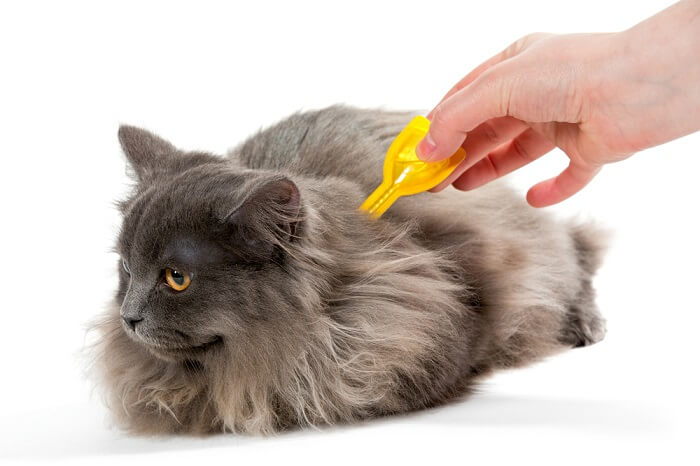
Frontline products have been around for over 20 years, and are considered by veterinarians to be generally safe to use as long as the feline only product is administered. The active ingredients are still largely considered to be effective against fleas and ticks as well.
Topical products like Frontline can all have different combinations of ingredients targeting different parasites that can sometimes be confusing. Make sure to clarify any questions you have about the best product for your kitty by having a chat with your vet.
Drug Dosing Disclaimer: We are only able to provide doses for medications that are FDA approved for use in cats and only as the label guidelines dictate. For medications that are used off-label we can only provide guidelines and safety information for use. Safe and appropriate dosing for off-label medications can only be determined by a primary care veterinarian.
We encourage you to work with your veterinarian to determine if a particular medication is appropriate for your cat. Changing or adjusting a dose for your cat on your own without consulting with a veterinarian can carry risk. We do not encourage use of medications prescribed for human use in pets without first consulting with a primary care veterinarian.
